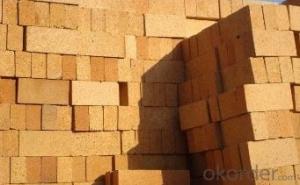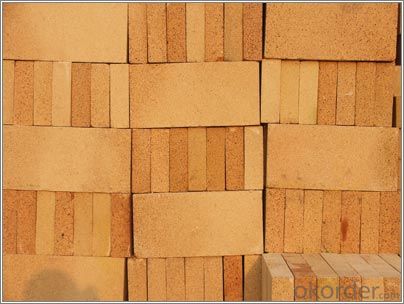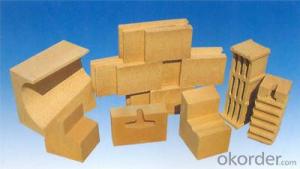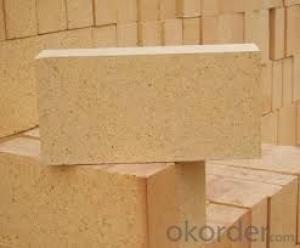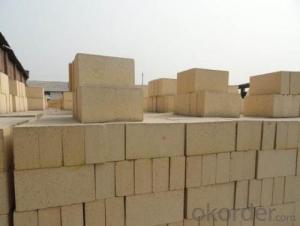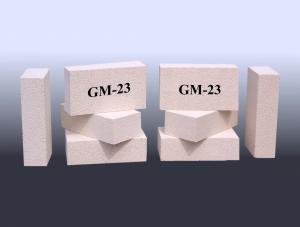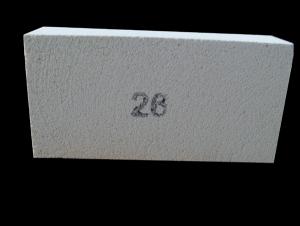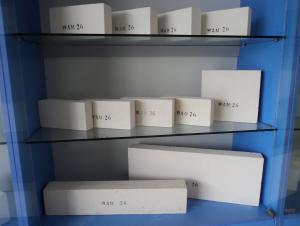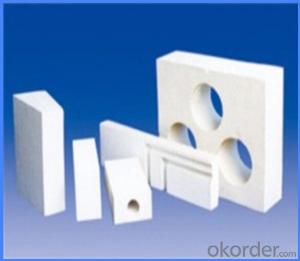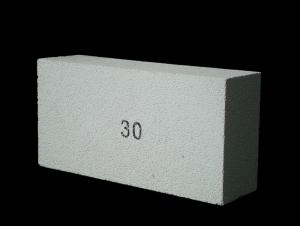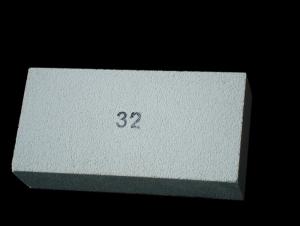High Alumina Insulating Fire Brick
- Loading Port:
- China Main Port
- Payment Terms:
- TT OR LC
- Min Order Qty:
- -
- Supply Capability:
- -
OKorder Service Pledge
OKorder Financial Service
You Might Also Like
Specifications
Fire brick1.ISO 9001 approved,
2.With high quality and competitive price,
3.Standard and special shape.
Fire-clay refractory brick.
1. N-1
AL2O3 (%)>42
Refractoriness >1750
Refractoriness under load KD>1400
Permanent linear change onreheating
1500*2h
1450*2h
1400*2h:+0.1; -0.4
Apparent Porosity(%)<22
Cold crushing strength (Mpa)>29.4
2. N-2a
AL2O3 (%)>40
Refractoriness >1730
Refractoriness under load KD>1350
Permanent linear change onreheating
1500*2h
1450*2h
1400*2h:+0.1; -0.5
Apparent Porosity(%)<24
Cold crushing strength (Mpa)>24.5
High-alumina refractory brick
1. LZ-75
AL2O3 (%)>75
Refractoriness>1790
Refractoriness under load KD>1520
Permanent linear change onreheating
1500*2h:+0.1; -0.4
1450*2h
1400*2h
Apparent Porosity(%)<23
Cold crushing strength (Mpa)>53.9
2. LZ-65
AL2O3 (%)>65
Refractoriness >1790
Refractoriness under load KD>1500
Permanent linear change onreheating
1500*2h:+0.1; -0.4
1450*2h
1400*2h
Apparent Porosity(%)<23
Cold crushing strength (Mpa)>49
3.LZ-55
AL2O3 (%)>55
Refractoriness >1770
Refractoriness under load KD>1470
Permanent linear change onreheating
1500*2h:+0.1; -0.4
1450*2h
1400*2h
Apparent Porosity(%)<22
Cold crushing strength (Mpa)>44.1
4.LZ-48
AL2O3 (%)>48
Refractoriness >1750
Refractoriness under load KD>1420
Permanent linear change onreheating
1500*2h
1450*2h:+0.1; -0.4
1400*2h
Apparent Porosity(%)<22
Cold crushing strength (Mpa)>39.2
Fire clay brick SK-32 | |
Item | Standard |
AI2O3(%) | 30 |
Fe2O3 (%) | 3.5 |
Refractoriness (SK) | 32 |
Refractoriness under load, 0.2MPa, Ta, (°C) | 1300 |
Porosity (%) | 22-26 |
Bulk density (g/cm³) | 2.05 |
Cold crushing strength (MPa) | 25 |
Thermal expansion at 1000°C (%) | 0.6 |
Fire clay brick SK-34 | |
Item | Standard |
AI2O3(%) | 38 |
Fe2O3 (%) | 2.5 |
Refractoriness (SK) | 34 |
Refractoriness under load, 0.2MPa, Ta, (°C) | 1350 |
Porosity (%) | 19-23 |
Bulk density (g/cm³) | 2.10-2.15 |
Cold crushing strength (MPa) | 25 |
Thermal expansion at 1000°C (%) | 0.6 |
Fire clay brick SK-36 | |
Item | Standard |
AI2O3(%) | 50 |
Fe2O3 (%) | 2 |
Refractoriness (SK) | 36 |
Refractoriness under load, 0.2MPa, Ta, (°C) | 1450 |
Porosity (%) | 20-24 |
Bulk density (g/cm³) | 2.30-2.40 |
Cold crushing strength (MPa) | 45 |
Thermal expansion at 1000°C (%) | 0.3 |


- Q: Can insulating fire bricks be used as a lining for kiln cars?
- Yes, insulating fire bricks can be used as a lining for kiln cars. These bricks are designed to withstand high temperatures and have excellent insulating properties, making them ideal for use in kilns where heat retention is required. Additionally, their lightweight nature makes them suitable for use on kiln cars, which need to be moved frequently.
- Q: What are the main components of insulating fire bricks?
- The main components of insulating fire bricks are typically a combination of alumina, silica, and various lightweight additives. Alumina (Al2O3) provides high temperature stability and resistance to thermal shock, making it a key component in insulating fire bricks. Silica (SiO2) helps to improve the refractory properties and insulation capabilities of the bricks. Additionally, lightweight additives such as vermiculite or perlite are often included to increase the insulating properties of the bricks. These components work together to create a material with excellent thermal insulation, low thermal conductivity, and high resistance to heat.
- Q: How do insulating fire bricks affect the overall fire resistance of a structure?
- The overall fire resistance of a structure is greatly enhanced by the presence of insulating fire bricks. These specialized bricks are designed to endure high temperatures and serve as an effective barrier against heat. By insulating the structure, they aid in minimizing heat transfer and the propagation of fire. The low thermal conductivity of insulating fire bricks allows them to resist heat transmission. This characteristic enables them to absorb and retain heat energy, preventing it from spreading to other parts of the structure. Consequently, the fire remains contained within a specific area, reducing the risk of it spreading to adjacent spaces. Additionally, insulating fire bricks possess a high melting point, rendering them highly resistant to heat. This quality enables them to endure prolonged exposure to intense temperatures without warping or disintegrating. By preserving their structural integrity, these bricks ensure the stability and overall integrity of the structure during a fire incident. Furthermore, insulating fire bricks serve as a barrier against flames and combustion gases. Their dense composition obstructs the passage of flames and smoke, preventing them from permeating the structure. This containment aids in limiting the damage caused by fire and provides occupants with valuable time to evacuate safely. In summary, the utilization of insulating fire bricks in constructing a structure significantly enhances its fire resistance. They provide insulation, prevent the propagation of fire, maintain structural stability, and act as a barrier against flames and smoke. By minimizing heat transfer and confining the fire, insulating fire bricks play a vital role in safeguarding the structure and its occupants during a fire emergency.
- Q: Are insulating fire bricks resistant to ammonia gas?
- Insulating fire bricks are generally not resistant to ammonia gas. While these bricks are designed to withstand high temperatures and provide thermal insulation, they are typically made from lightweight refractory materials such as clay or silica, which are not highly resistant to corrosive substances like ammonia gas. Ammonia gas can react with these materials and cause degradation or damage to the bricks over time. Therefore, if you need to use fire bricks in an environment with ammonia gas, it is recommended to choose specially designed acid-resistant or chemical-resistant bricks that can withstand the corrosive effects of ammonia gas.
- Q: Are insulating fire bricks eco-friendly?
- To some extent, insulating fire bricks can be considered environmentally friendly. These bricks are typically crafted from abundant natural materials like clay, shale, and other fire-resistant minerals. The manufacturing process involves firing the bricks at high temperatures, which can consume a lot of energy. However, advancements in manufacturing techniques have mitigated the environmental impact by using more efficient kilns and recycled materials. Furthermore, insulating fire bricks boast a long lifespan and can endure high temperatures. This means they require less frequent replacement compared to other brick types, resulting in reduced waste generation and resource consumption over time. Moreover, these bricks possess exceptional thermal insulation properties, which can contribute to decreased energy consumption in various applications. By minimizing heat loss, insulating fire bricks can enhance energy efficiency and reduce carbon emissions in both buildings and industrial processes. Nevertheless, it is crucial to note that the eco-friendliness of insulating fire bricks also hinges on their proper disposal at the end of their life cycle. If not recycled or disposed of appropriately, they can contribute to landfill waste and potential environmental pollution. In conclusion, while insulating fire bricks offer certain environmentally friendly features, such as being made from natural materials and their energy-saving properties, their overall environmental impact also depends on responsible manufacturing, usage, and disposal practices.
- Q: Can insulating fire bricks be used in ladles?
- Certainly! Ladles can indeed utilize insulating fire bricks. These bricks are specifically engineered to endure extreme temperatures while offering thermal insulation. They find frequent application in situations where the maintenance or regulation of high temperatures is necessary, like furnaces, kilns, and ladles. Ladles are employed for the purpose of pouring and transferring molten metal or other substances. By incorporating insulating fire bricks into ladles, heat loss is reduced and energy efficiency is enhanced. Moreover, these bricks serve as a safeguard against chemical reactions and erosion stemming from the molten materials, thus qualifying them as suitable for ladle usage.
- Q: Can insulating fire bricks be used for insulation in hot blast stoves?
- Yes, insulating fire bricks can be used for insulation in hot blast stoves. Insulating fire bricks are designed to withstand high temperatures and have excellent thermal insulation properties. They are made from lightweight materials with low thermal conductivity, which allows them to effectively retain heat and prevent heat transfer to the surrounding environment. In hot blast stoves, where temperatures can reach extremely high levels, insulating fire bricks can help maintain high temperatures inside the stove while minimizing heat loss. This not only improves the energy efficiency of the stove but also helps to protect the structure from excessive heat. Therefore, using insulating fire bricks for insulation in hot blast stoves is a common and effective practice.
- Q: Can insulating fire bricks be used in the construction of aluminum smelting furnaces?
- Yes, insulating fire bricks can be used in the construction of aluminum smelting furnaces. These bricks have excellent thermal insulation properties, allowing them to withstand high temperatures without transferring heat to the surrounding environment. This makes them suitable for lining the walls and floors of aluminum smelting furnaces, helping to maintain the desired temperature inside the furnace while minimizing heat loss.
- Q: Do insulating fire bricks require any maintenance?
- Insulating fire bricks, also known as refractory bricks, are designed to withstand high temperatures and provide excellent insulation properties. One of the advantages of insulating fire bricks is that they require very little maintenance. These bricks are made from special materials that have high resistance to heat and thermal shock. As a result, they do not crack or break easily, reducing the need for frequent repairs or replacements. However, like any other material, insulating fire bricks can accumulate dust or debris over time. Regular cleaning is recommended to maintain their effectiveness and prolong their lifespan. This can be done by using a soft brush or vacuum cleaner to remove any loose particles. In addition, it is important to inspect the bricks periodically for any signs of damage, such as cracks or erosion. If any issues are identified, they should be addressed promptly to prevent further deterioration. Overall, while insulating fire bricks do not require extensive maintenance, regular cleaning and inspection are essential to ensure their optimal performance and longevity.
- Q: Are insulating fire bricks resistant to alkali vapor attack?
- Yes, insulating fire bricks are generally resistant to alkali vapor attack. They have a high degree of chemical stability and can withstand exposure to alkali vapors without significant degradation or damage.
Send your message to us
High Alumina Insulating Fire Brick
- Loading Port:
- China Main Port
- Payment Terms:
- TT OR LC
- Min Order Qty:
- -
- Supply Capability:
- -
OKorder Service Pledge
OKorder Financial Service
Similar products
Hot products
Hot Searches
Related keywords
